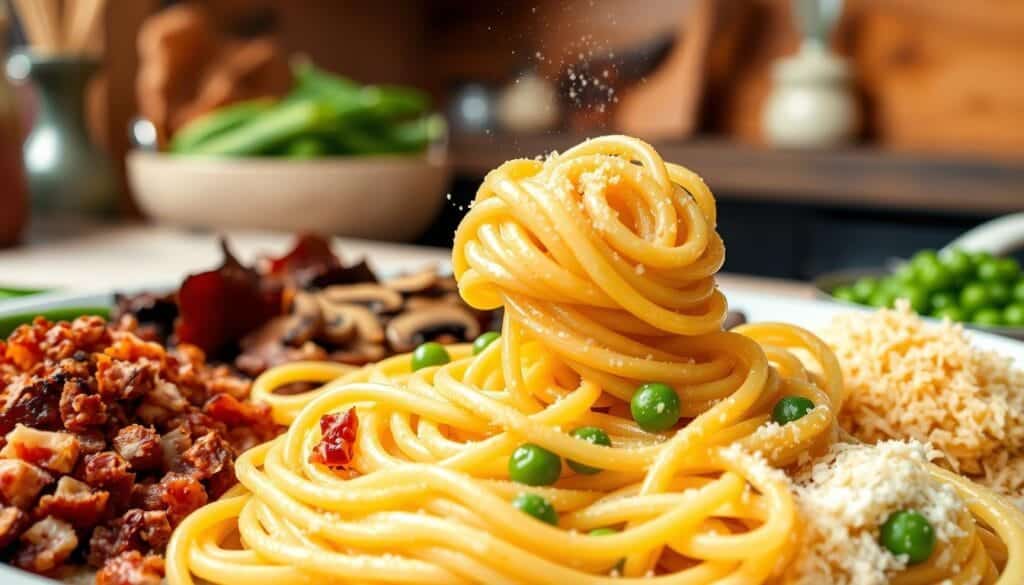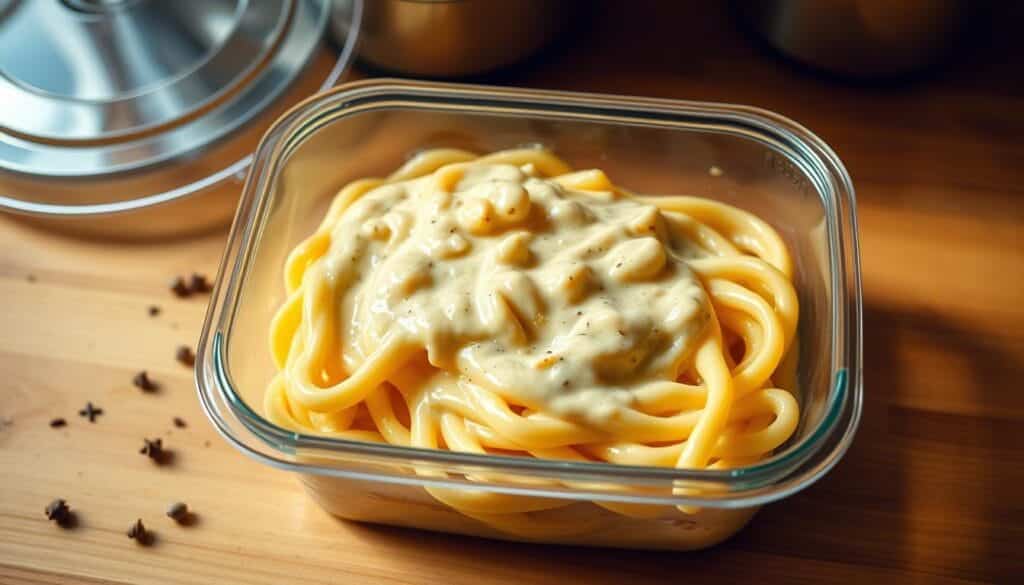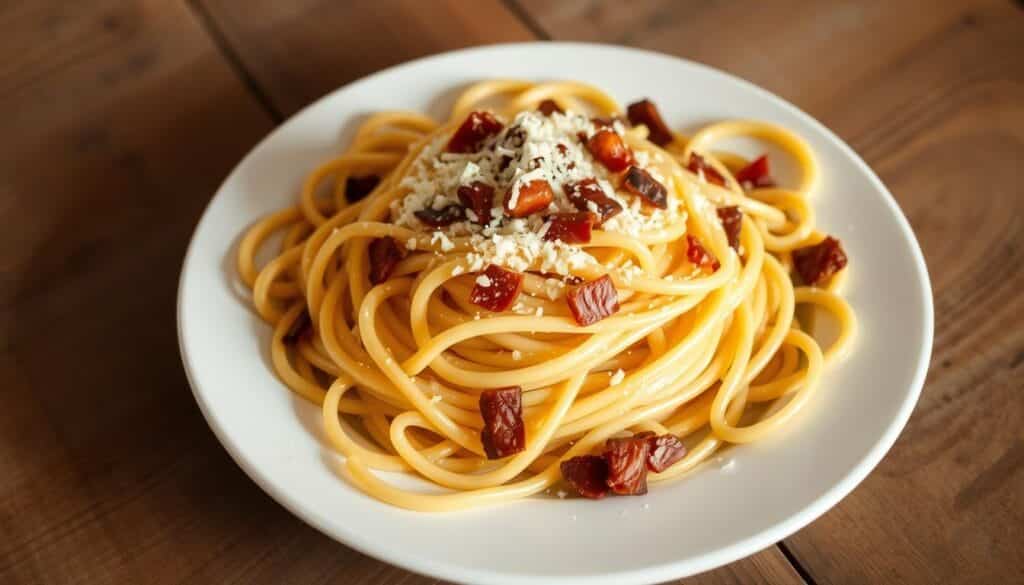There’s something comforting about a bowl of classic spaghetti carbonara. It’s creamy, salty, and warm. My Nonna used to make it on Sundays, and the smell of pancetta was a sign to slow down and enjoy.
Today, I’m sharing that Homemade Carbonara Recipe with you. It’s about memory and technique.
This recipe is quick, taking just 30 minutes. You’ll need 14 ounces of spaghetti, 5 ounces of guanciale, and 3 eggs. It’s a simple way to make a special night out of a weeknight.
It has 493 glowing reviews and a 4.99/5 rating. It shows how simple ingredients can make a big difference.
I’ve learned the hard way about overcooked pasta and scrambled eggs. But this method ensures perfect noodles and a sauce that sticks. Let’s make it right, step by step. You’ll see why fresh Parmesan and 1 cup of pasta water are key. Ready to bring Italy into your kitchen? Let’s start.
What is Carbonara?
Let me share a secret: traditional Italian carbonara is more than a dish—it’s a story. It was born in post-war Rome, filled with warmth. The name comes from charcoal burners (carbonari), who used simple ingredients. Today, authentic carbonara keeps this tradition alive, blending simplicity with deep flavors. Let’s explore its magic.
A Brief History of the Dish
In the 1940s, Rome’s scarcity led to creativity. Charcoal workers and families used pasta, eggs, and cheese. This simple meal became a comfort symbol, showing joy in simplicity.
Key Ingredients in Carbonara
- Cheese: Pecorino Romano’s sharpness is perfect, but Parmigiano adds richness in many homes.
- Eggs: Whisked with cheese and pasta water, they make a creamy sauce without cream.
- Black pepper: Freshly cracked, it adds a fiery touch.
Every bite tells a story of tradition, resourcefulness, and love. Now, let’s see how these ingredients come together to make that iconic sauce.
Essential Ingredients for Homemade Carbonara
Every great carbonara starts with familiar ingredients. Let’s explore what makes this dish special, beginning with the pasta. Choose spaghetti or bucatini for a classic taste. Tonnarelli is also great, with its ridges that hold the sauce tight.
Pasta Selection
Go for long, thin pasta shapes. Spaghetti balances the sauce perfectly. Bucatini traps sauce in its hollow center, making each bite rich. Choose durum wheat pasta for a chewy texture.
Sauce Components
Eggs, cheese, and cured beef come together in a delicious mix. Use room-temperature eggs for a smooth blend. Pancetta adds smoky flavor, but bacon works too. Black pepper adds a spicy touch.
Choosing the Right Cheese
Parmigiano-Reggiano and Pecorino Romano are a perfect pair. Grate them fresh for the best flavor. If Pecorino is hard to find, mix it with Parmesan. This cheese is the heart of your sauce.
Every ingredient has its own story. Take your time choosing each one. Let them share their secrets in your dish.
Preparing the Ingredients
Before we dive into the creamy carbonara recipe, every step is crucial. Think of it like building a house—each brick matters. Start with the pasta. I prefer De Cecco bronze-cut spaghetti for its ridges, which hold onto the sauce.
Bring salted water to a boil, then add the pasta. Cook it a minute less than the package suggests. The pasta will finish cooking in the residual heat.
Cooking the Pasta
Set a timer for 8-10 minutes. Stir occasionally to avoid tangling. When the pasta is almost al dente, remove a cup of starchy water.
Drain but don’t rinse the pasta. That starch is what makes the sauce creamy.
Preparing the Guanciale or Pancetta
Cut the cured beef into small pieces. Heat olive oil in a skillet until it shimmers. Add the meat and listen for sizzling.
Cook until the edges curl but stay tender. Remove the meat and leave the fat behind. It’s the base of your sauce’s richness. Remember, 100 chefs say guanciale’s fat makes the best homemade carbonara.
Room-temperature eggs are essential. Cold eggs can cause the sauce to scramble. Let the eggs sit on the counter while the pasta cooks. Now, you’re ready to mix everything together without shortcuts!
How to Make Homemade Carbonara
Making the best carbonara recipe takes patience and precision. But the end result is a dish that feels like a warm hug. Let me guide you through the steps to create this easy carbonara sauce that’s velvety and rich.
Step-by-Step Cooking Instructions
- Start by whisking the egg mixture: In a warm bowl, mix 5 egg yolks, 1 whole egg, ½ cup grated Pecorino, and a lot of black pepper. Let it sit at room temperature while you cook the pasta.
- Cook spaghetti in 10 cups of salted water until it’s just under tender. Before draining, save ½ cup of pasta water.
- Cook pancetta in a skillet until it’s crispy (20-25 minutes). Remove it, then toss the hot pasta with the fat. Turn off the heat!
- Slowly add the egg mixture to the hot pasta, stirring quickly. Add reserved water a tablespoon at a time until it’s silky.
- Immediately serve in warm bowls. Add fresh pepper and Pecorino on top—no waiting!
Tips for Perfecting the Sauce
- Let eggs warm up to room temperature to avoid scrambling. This is the secret to the best carbonara recipe!
- Use a warm serving bowl to keep the sauce from breaking. I warm mine in a 200°F oven while cooking.
- Don’t rush! The residual heat works its magic—stir gently but decisively.
This 25-minute process turns simple ingredients into something unforgettable. With 6 portions, each with 361 calories, it’s a hearty dish that warms both belly and soul. Remember, patience and timing are key—trust the method that’s stood the test of time. Enjoy the aroma, the golden pancetta, and that first creamy bite. Now go make that sauce sing!
Common Mistakes to Avoid
There’s nothing worse than spending hours on a meal only to have it fail. Let’s discuss the mistakes I’ve made and how to fix them. This way, your authentic carbonara will be a hit. Every step, from cooking to serving, is crucial.
Overcooking the Pasta
Imagine your spaghetti becoming mushy during dinner. To prevent this, cook pasta al dente. It should still have a bit of firmness. Cook it 1-2 minutes less than the package suggests. Taste it often! Overcooked noodles can’t hold the sauce of traditional Italian carbonara.
Using Low-Quality Ingredients
Guanciale’s rich flavor is essential. Use pancetta only if guanciale is hard to find, but the taste won’t be the same. Freshly grated Pecorino Romano is worth the cost. Avoid pre-grated cheese, as it can make the sauce clumpy.
- Temperature trouble: Keep the pan off the heat when tossing eggs and pasta. Scrambled eggs aren’t part of the recipe.
- No cream, please: The sauce’s creaminess comes from pasta water and emulsion—not dairy. Adding cream is a modern twist that dilutes tradition.
- Don’t rinse the pasta: Starch is your friend. Those golden specks clinging to the noodles help bind the sauce.
Patience is key. Let the sauce rest for a moment after tossing. This allows the residual heat to finish the job. Now you’re ready to enjoy that velvety bite that defines traditional Italian carbonara. Happy cooking, and remember: mistakes mean you’re learning!
Variations of Carbonara
Carbonara doesn’t have to be the same every time. Its creamy base can be changed up. Swapping proteins keeps the easy sauce’s core. Let’s see how to make it your own.

Vegetarian Carbonara Options
For plant-based meals, the sauce’s richness is key. Try these ideas:
- Umami boost: Sauté king oyster mushrooms with smoked paprika until caramelized. Their meaty texture pairs perfectly with Pecorino.
- Springtime twist: Add blanched asparagus spears or roasted cherry tomatoes for a vibrant pop of color.
- Asian flair: Marinate firm tofu in soy sauce and sesame oil before crumbling it into the sauce. The result? A silky, meat-free version.
Seafood Carbonaraa Recipes
Seafood makes carbonara light yet luxurious. My favorites include:
- Shrimp surprise: Toss plump shrimp into the pan just before tossing with pasta. A squeeze of lemon adds brightness.
- Salmon’s touch: Pan-sear salmon fillets and flake them into the sauce. Finely grated bottarga (fish roe) adds a delicate crunch.
These variations keep the sauce’s core technique—off-heat emulsification—intact. Whether using a skillet or adding fresh herbs, the creamy texture stays central. For more inspiration, explore global twists while keeping the sauce’s integrity.
| Style | Protein | Signature Touch |
|---|---|---|
| Vegetarian | shiitake mushrooms | smoked paprika |
| Seafood | shrimp & mussels | lemon zest |
| Gluten-Free | zucchini ribbons | extra Pecorino |
Remember—adjust ingredients but never skip the golden rule: always mix sauce off the heat. These variations prove that tradition and innovation can coexist. What will your next carbonara adventure be?
Serving Suggestions
Serving the best carbonara recipe right can make it unforgettable. Warming bowls and pairing dishes thoughtfully are key. For a quick carbonara dinner idea, serve the pasta in hot dishes to keep it creamy. A sprinkle of parsley or extra Parmesan makes it feel like a restaurant meal.
The perfect pairing isn’t just about taste—it’s harmony between flavors.
Complementary Sides to Elevate Your Plate
Let your carbonara be the star with sides that enhance it. A peppery arugula salad with lemon and Parmesan refreshes the palate. Crusty bread or garlic bread soak up the sauce. For a light touch, try roasted asparagus or cherry tomatoes.
- Arugula salad with lemon dressing
- Garlic-rubbed bread or toasted baguette
- Roasted vegetables like asparagus or tomatoes
Remember, presentation is important. A sprinkle of pepper at the table lets guests add their own touch. Serve immediately for the best sauce texture. Enjoy it with loved ones while it’s hot. Every detail adds to the warmth of your meal.
Storing Leftovers

Sometimes we make more homemade pasta recipe than we can eat right away. Don’t worry, leftovers can still be great with the right care. Let’s keep that creamy goodness fresh and tasty.
Proper Storage Techniques
Always cool leftovers quickly after serving. Move them to an airtight container and refrigerate within 2 hours. Keep them in the fridge for up to 3-4 days—never freeze. The sauce’s delicate texture won’t hold up in the freezer.
| Storage Steps | Why It Matters |
|---|---|
| Cool pasta quickly | Prevents bacterial growth |
| Use airtight containers | Keeps flavors fresh |
| Use within 3-4 days | Maintains quality and safety |
Reheating Tips for Creamy Results
Reheat gently to keep that silky texture. For a quick carbonara dinner idea:
- Stovetop method: Gently warm in a pan over low heat with 1-2 tbsp water or broth.
- Microwave method: Heat in 30-second bursts, stirring after each interval.
- Add a pinch of pepper or fresh cheese to revive flavors.
A word of advice: Avoid overheatingng. The eggs in the sauce scramble easily. For a change, try adding a drizzle of olive oil while warming. If you’re craving something new, explore chorizo-inspired twists for future meals.
Conclusion: Enjoying Your Homemade Carbonara Recipe
Every bite of homemade carbonara brings centuries of Italian tradition to your table. This recipe, with 535 calories per serving, turns simple ingredients into a comforting dish. It’s perfect for a cozy night or a special occasion, and you can make it your own.
Final Thoughts on Customization
Begin with the basics: spaghetti, eggs, and Pecorino. But don’t stop there. Add red pepper flakes or toasted breadcrumbs for extra flavor. The 20g of fat in each serving makes it both indulgent and nourishing.
Feel free to swap guanciale for bacon if needed. This dish is as flexible as it is delicious, teaching you the value of patience.
Encouragement to Experiment with Flavors
Don’t be afraid to try new things. Add sautéed mushrooms or arugula for a twist. For a lighter option, use less pancetta or mix in vegan cashew cream.
This recipe makes 4 servings, but you can make it your own. Share it with family or friends and enjoy the process. Remember, even in Rome’s 1839, people added their own touches. Your kitchen is where this classic comes to life. Buon appetito, and may every meal be a celebration of love.
We are interested in your feedback
Catchy recipe
Sounds delicious
Original idea
Yummy
Healty and nutritious
Well done
Interesting
Just good

